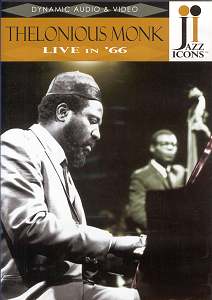This is part of an
ongoing Jazz Icons series that presents
previously unreleased - perhaps that
should be previously officially unreleased
– concert footage. The production values
are high and all questions of royalties
and other responsibilities have been
attended to with laudable respect. The
booklet features an introduction by
Monk’s son and an extensive essay by
Don Sickler, a Jazz Icons consultant
and Monk specialist. There are colour
reproductions in montage of sleeve jackets,
playbills and journal covers featuring
Monk and some well-reproduced photographs.
The package itself
gives us two Scandinavian concerts,
lasting half an hour each, recorded
within days of each other during a European
tour in 1966. In addition to Monk and
his long-standing tenor player Charlie
Rouse the quartet comprised bassist
Larry Gales and drummer Ben Riley.
The first concert took
place in Norway in what looks like the
atrium of an Art Museum. There was no
audience. The sound has been brilliantly
restored. It sounds crisp, immediate
and impressive. The visuals however
are rather grainy and have suffered
degradation. Those tell-tale lines that
streak horizontally down the picture
give a rather antique air to proceedings
though in truth it’s no worse than many
films of the period. One does however
get a shock when the audio and visual
images are so different, the ear anticipating
a similarly muffly sound perspective.
The second concert
has similarly good sound and thankfully
far better picture quality with the
proviso that – both concerts were filmed
in black and white – the image can get
a bit dark now and then. Clarity however
remains untroubled; sweat and ruffled
cuffs are pleasingly visible.
Camera angles vary.
In the first concert there’s a nostril-intrusive
shot from beneath Rouse, though the
camera pans over to Monk soon enough.
In the second concert we have a few
geometricians wielding the cameras.
There’s a shot of the pianist, face
on, taken through the piano lid, which
has its stick up. We also get a few
shots of Riley "through" the
piano as well, which involves a clever
use of angles.
The band is caught
in semi-private moments, as for instance
when Rouse and Riley are seen mildly
fooling about during Monk’s solo on
Don’t Blame Me. We see Riley
stubbing out a cigarette as the band
goes into its closer, Epistrophy,
in the Danish concert. Doubtless today
he’d be doused in foam and arrested.
Monk of course sports his trademark
headgear. He sweats violently and stands
up to dance with a slow- motion circular
shuffle with elevated left elbow raise
as other band members solo (he, famously,
tended to sit out the accompanying to
add some variety and enjoyed this incantation-like
shuffle). I’d not realised before quite
how much percussive and quite unnecessary-seeming
hands-crossing Monk indulged in. His
left hand is forever where his right
should be and vice versa.
The intricacies and
subtleties of rhythm establishment between
Monk and Rouse were now fully in place.
To watch both men is to see trust and
goading in action. Rouse was often scoffed
at, especially in his later days, for
being some kind of journeyman but irrefutable
evidence to the contrary exists wherever
one wishes to find it. Riley and Gales
are irreproachable colleagues.
The tune selection
is standard for the quartet. Lulu’s
Back in Town opens both concerts
and we also hear Blue Monk and
’Round Midnight in addition to
the two songs mentioned above. One of
the pleasures of this DVD lies in hearing
the significant divergences between
the two versions of Lulu’s Back in
Town.
If this disc is representative
of the Jazz Icons series than we can
look forward to some thoughtfully presented
and historically important concerts.
Jonathan Woolf
